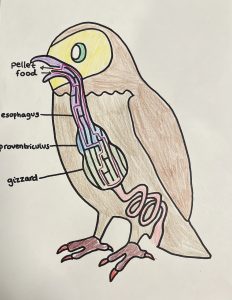49 Owl pellets: They’re Regurgitastic!- Instructor guide
Owls, diets and regurgitation
Created by E Banks, E Yeager, and H Burling; members of the University of Minnesota veterinary class of 2027
Instructional Guide
What happens to the bones when owls eat mice?
This activity is designed to help students explore species differences in anatomy, starting with birds. It should spark interest in the world around them and help students realize that animals have different mechanisms of coping with the inedible parts of their food. Secondarily, this activity should help students develop computer manipulative skills.
Intended grade level
Grades 3-5, this is best done when connected to life science units. Students should be familiar with basic human anatomy, especially terms such as esophagus, stomach, and digestion.
Minnesota science state standard connections
4.1.1 Students will be able to engage in argument from evidence for the explanations the students construct, defend and revise their interpretations when presented with new evidence, critically evaluate the scientific arguments of others, and present counterarguments
3L.4.1.1.1 Construct an argument about strategies animals use to survive. (P: 7, CC: 2, CI: LS2)
4.2.1 Students will be able to read and interpret multiple sources to obtain information, evaluate the merit and validity of claims and design solutions, and communicate information, ideas, and evidence in a variety of formats.
3L.4.2.1.1 Obtain information from various types of media to support an argument that plants and animals have internal and external structures that function to support survival, growth, behavior, and reproduction.** (P: 8, CC: 4, CI: LS1)
Student learning objectives
- Students will be able to compare and contrast owl GI anatomy and human GI anatomy
- Students will be able to describe owl internal structures and how they function to support growth and survival.
Lesson format
This activity is expected to take 30-45 minutes. It can be done in the classroom, with students working in pairs or small groups.
- Introductory conversation which includes review of human digestion. (5-10 minutes)
- Start by asking students questions about their favorite food and how they eat them. You can prompt students by asking how they would eat a tough piece of meat or how they would eat a head of broccoli and what tools would they use.Have students discuss which teeth they use to bite food. Which teeth they use to break food up (grind the food). Discuss how we chew food to help break it up for our stomachs to digest it easier. Remind students how we digest food.
- Next, engage students in a conversation about owls including what they look like and how their mouths differ from other animals. Ask students to hypothesize how owls grind their food.“How they are different from our mouths? Do they have teeth? How do they grind up their food?” This conversation will prepare students for the main activity.
- Owl Digestion video and coloring activity (20 minutes)
- Smartboard for video
- Copies of owl digestion coloring page and human digestion coloring page
- Colored pencils and markers
- Optional: Owl pellet dissectionStudents will watch the dissection of a play do owl pellet followed by an interactive online dissection.Optional play doh dissection: Wrap play doh around small objects that might or might not be eaten by an owl. Have students sort the items into piles of what might be realistic and what isn’t. Older students could research owl diets as a supplementary activity.
- The assessment will be a matching game in which students must drag and drop brief labels of what of the owl GI system does to the proper place (5 minutes)
Activities
Students will watch a 5 minute video on owl digestion, followed by a coloring activity that helps them compare owl and human digestive tracts. Students can work together in small groups and color the digestive tracts of the owls and humans in similar color according to function. Ie. the esophagus in the owl and the esophagus in the human can be the same color.
Here is an example of a filled-out maze.

You may provide other books or stations in the classroom where students can independently learn more about different organs and their functions.
Students will also have the choice, depending on resources, to dissect an owl pellet. This can be done with real owl pellets, play-doh mock-ups as described above, or through a virtual game Sherlock Bones Mystery
Assessment
Students will match what portions of the owl’s GI tract does to sections of their image in a drag-and-drop manner to affirm their new understanding of the owl GI tract.
Further exploration
Check out similar lessons in this book if you would like to learn more about this topic:

